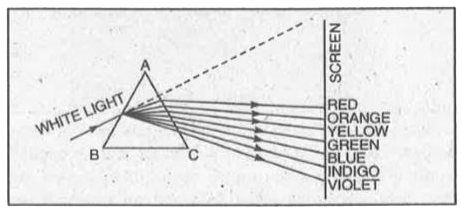Explain the phenomenon of Dispersion. Red and blue light rays are incident on a given prism. Explain which will have greater value of minimum deviation.
Dispersion of Light
The phenomenon of splitting of white light into its constituent colours, on passing through a prism is called Dispersion of light. The band of colours so obtained is called a spectrum.
White light e.g. light from the sun, when seen through a prism, appears coloured.

Thus white light splits into different colours, on passing through a prism. The colours in the order of decreasing deviation are Violet, Indigo, Blue, Green, Yellow, Orange and Red (Fig.). Obviously, the deviation is maximum for violet colour and minimum for red colour,
Cause of Dispersion
The wavelength of red light (in the visible spectrum) is much larger than that of violet light and the wavelength of orange, yellow, green, blue and indigo colours lying in between red and violet light gradually decreases in the above order.
According to Cauchy.s formula,
μ=a+bλ2+cλ4,
where λ is the wavelength of light and μ is the refractive index for the particular wavelength i.e. velocity of light is different for different wavelengths. As the wavelength of blue light is smaller than that of red light, the refractive index for blue light is greater than that for red light.
i.e. since λb<λr
∴μb>μr
We know that, the deviation δ for a small angled prism is given by
δ=(μ−1)A
So λb>λr
Topper's Solved these Questions
- OPTICSBOOK - MBD -HARYANA BOARDCHAPTER - OPTICSEXERCISE - LONG ANSWER TYPE QUESTIONS
18 Videos
- OPTICSBOOK - MBD -HARYANA BOARDCHAPTER - OPTICSEXERCISE - OBJECTIVE TYPE QUESTIONS
26 Videos
- OPTICSBOOK - MBD -HARYANA BOARDCHAPTER - OPTICSEXERCISE - OBJECTIVE TYPE QUESTIONS
26 Videos
- MODEL TEST PAPER - 2BOOK - MBD -HARYANA BOARDCHAPTER - MODEL TEST PAPER - 2EXERCISE - SET - D ( LONG ANSWER TYPE QUESTIONS)
4 Videos
- PRINCIPLES OF COMMUNICATIONBOOK - MBD -HARYANA BOARDCHAPTER - PRINCIPLES OF COMMUNICATIONEXERCISE - Objective Type Questions
19 Videos
Similar Questions
Knowledge Check
The refracting angle of a prism is 40∘. A ray of light is incident at angle 38∘ and passes in the position of minimum deviation. The angle of minimum deviation is
A40∘B38∘C36∘D32∘The angle of incidence for a ray of light at a refracting surface of a prism is 45∘. The angle of prism is 60∘. If the ray suffers minimum deviation through the prism, then the angle of minimum deviation is:
A30∘B60∘C45∘D90∘
Explain the relation between angle of incidence and deviation for a prism
View SolutionAre the incident of emergent rays symmetrical with respect to the base of a prism in minimum deviation position ?
View SolutionIn Fig. 6(b).80, light rays of blue, green and red wavelength are incident on an isoscels right angled prism. Explain with reason which ray of light will be transmitted through the face AC. The refractive index of the prism for red, green and blue light are 1.39,1.424 and 1.476 respectively.

View SolutionFind the angle of incidence of a light ray on an equilateral prism of refractive index μ=√2 for which light will suffer minimum deviation also find this minimum deviation angle.
View SolutionPlot a graph to show the variation of the angle of deviation as a function of angle of incidence for light rays passing through a prism. Write the relation for the refractive index of the prism in terms of the angle of minimum deviation and the angle of the prism.
View SolutionDetermine the speed of light through an equilateral prism for which a ray of light incident on it shows a minimum deviation of 30∘.
View Solution
